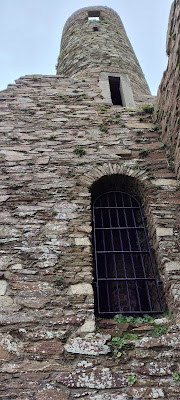Ferns, Wexford.

Ferns in County Wexford may possible be so named after
Fearn, Fearnóg or Fearna, the Irish for Alder, a species of native tree.

The village is associated with Saint Aidan and was once the site of a large and substantial ecclesiastical settlement.

A comprehensive ground penetrating LIDAR survey was completed a few years back with efforts to establish and determine the full extent of the settlement.

Diarmait Mac Murchada (Dermot MacMurrough) is buried here.


The infamous King of Leinster, who is credited with "inviting" the Normans under Strongbow (Richard de Clare) and King Henry II of England into Ireland c. 1169 A.D. in order to maintain his own hold on power and local hegemony is buried in the grounds of Saint Aidan's Cathedral beside the partial remains of the embossed shaft from an Early High Cross.


The present Cathedral Church of Saint Edan (Aidan) stands where once stood Saint Aiden's Monastery sometime in the 7th Century. When Aidan died he was succeeded by Saint Moling of Saint Mullins (a beautiful ecclesiastical site) in nearby Carlow.

There are four plain imperforate High Crosses in the Cathedral grounds and an inscribed Cross Stone.

These may well have been brightly painted depicting biblical scenes or themes around the time they were constructed, no one is quite sure whether they were painted or not but considering the effort put into carving the more decorative and highly artistic High Crosses it would appear logical that they may have been also beautifully painted.

On both my visits the Cathedral itself was closed which was a pity.

In the grounds of the Cathedral are the remains of an early Chapter House, the administrative building of the site and it dates to c. the 1300's.

Roughly 100 metres across an open field and easily seen and walked to is Saint Mary's Abbey, the remains of an Augustinian Abbey. In its grounds are the bases from two further High Crosses.



Of particular interest are the remains of a Round Tower which is attached to the building itself. Its Square base is unusual and atypical for the type.
Saint Mogue's Cottage beside the Cathedral is an ongoing OPW (Office of Public Works) project which was closed when I visited. Nonetheless it is a beautiful example of earlier vernacular architecture and its restoration a credit to the OPW itself.
Ferns Castle further up in the village is a partially destroyed Castle of Norman origin.
These impressive early Norman
stone built Castles are generally credited to William Marshal, a Norman Earl and sometimes known as the "Castle builder" and were first constructed in Ireland during the 13th Century.
Saint Mogue's Well is a place of devotion and Holy Well which lies just across the road from the Cathedral in Ferns.
It is well worth taking the time to visit if just to spend a few quiet minutes in reflection or contemplation or listening to the whispered gurgling of the crystal clear water.
Below is Saint Mary's Abbey with its partial Round Tower on a Square base.
Also buried in the grounds of Saint Edan's Cathedral Church is Father John Murphy.
Captured and killed at Tullow in Carlow for his part in the 1798 United Irishmen rebellion, he was born here in Ferns where a Contemporary Celtic Cross memorial was erected to his memory in the village.
At Tullow he was whipped, hung, decapitated, his body burned in a barrel of Tar and his head impaled upon a spiked railing.
It was after 1798 and because the insurgents were multi-denominational that the British authorities decided the only way they could continue to control Ireland was to turn the Irish against one another by using religion as a basis for destroying any Irish unity and further encouraging sectarian divisions within the Country.
The British program was ultimately successful and kept Britain nominally in control until the Irish War of Independence.
Unfortunately the consequences and violence derived from British encouraged sectarianism and division are still to be felt to this day and the Country is also still divided by an illogical and invisible Northern border.
Such were the vagaries of Perfidious Albion, inflicted globally upon virtually every nation she ever invaded and rapaciously stole from as "the Sun never set on the glorious British Empire".
Divide and Conquer.
About 200 meters downhill and across the road from the Cathedral is Saint Peter's Church.
At this point in time no one has been able to accurately date this unusual little Church ruin.
Saint Peter's Church contains various elements of contradictory time periods and is not recorded in the 1500's.
There are 13th Century ogee style windows alongside an earlier decorated Romanesque window. As such it is assumed that the Church is a post 1500's Church of uncertain origin and constructed from a composite of materials taken from other Churches in the area.
It's quite a delightful and enchanting setting, very bucolic. Do take the time to visit if in the area. It is easily missed.
There is a Walking Heritage Trail of Ferns and small little metal markers are placed into the groung at points of interest throughout the Village.
Below I've included various photographs taken around the village and its immediate environs.
Keep the Wheels turning.































































































